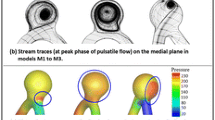Abstract
To identify shortcomings in the design of conventional endovascular devices, we investigated the inflow features of untreated aneurysms at a variety of arterial bends using computational fluid dynamics. As a preliminary study, we analyzed the steady-state inflow for aneurysms created at U-shaped, twisted, and S-shaped arteries. Both the inflow pattern and inflow flux were strongly influenced by the shape of the artery and the configuration angle of the aneurysm to the artery. We revealed that the secondary flow generated in the parent artery is the dominant factor affecting the inflow. Our results suggest that the arterial geometry and secondary flow should be considered in the design of endovascular devices.






Similar content being viewed by others
References
Byun H. S., K. Rhee 2004 CFD modeling of blood flow following coil embolization of aneurysms. Med. Eng. Phys. 26:755–761. doi:10.1016/j.medengphy.2004.06.008
Castro M. A., C. M. Putman, J. R. Cebral 2006 Computational fluid dynamics modeling of intracranial aneurysms: effect of parent artery segmentation on intra-aneurysmal hemodynamics. Am. J. Neuroradiol. 27:1703–1709
Cebral J. R., R. Löhner 2005 Efficient simulation of blood flow past complex endovascular devices using and adaptive embedding technique. IEEE Trans. Med. Imaging 24:468–476. doi:10.1109/TMI.2005.844172
Ford M. D., S.-W. Lee, S. P. Lownie, D. W. Holdsworth, D. A. Steinman 2008 On the effect of parent-aneurysm angle on flow patterns in basilar tip aneurysms: toward a surrogate geometric marker of intra-aneurysmal hemodynamics. J. Biomech. 41:241–248. doi:10.1016/j.jbiomech.2007.09.032
Gobin Y. P., J. L. Counord, P. Flaud, J. Duffaux 1994 In vitro study of haemodynamics in a giant saccular aneurysm model: influence of flow dynamics in the parent vessel and effects of coil embolisation. Neuroradiology 36:530–536. doi:10.1007/BF00593516
Guglielmi G., F. Vinuela, G. Duckwiler, J. Dion, P. Lylyk, A. Berenstein, C. Strother, V. Graves, V. Halbach, D. Nichols, N. Hopkins, R. Ferguson, I. Sepetka 1992 Endovascular treatment of posterior circulation aneurysms by electrothrombosis using electrically detachable coils. J. Neurosurg. 77:515–524
International Study of Unruptured Intracranial Aneurysms Investigators 2003 Unruptured intracranial aneurysms: natural history, clinical outcome, and risks of surgical and endovascular treatment. Lancet 362:103–110. doi:10.1016/S0140-6736(03)13860-3
Isoda H., M. Hirano, H. Takeda, T. Kosugi, M. T. Alley, M. Markl, N. J. Pelc, H. Sakahara 2006 Visualization of hemodynamics in a silicon aneurysm model using time-resolved, 3D, phase-contrast MRI. Am. J. Neuroradiol. 27:1119–1122
Ku J. P., C. J. Elkins, C. A. Taylor 2005 Comparison of CFD and MRI flow and velocities in an in vitro large artery bypass graft model. Ann. Biomed. Eng. 33:257–269. doi:10.1007/s10439-005-1729-7
Liou T.-M., Y.-C. Li, W.-C. Juan 2007 Numerical and experimental studies on pulsatile flow in aneurysms arising laterally from a curved parent vessel at various angles. J. Biomech. 40:1268–1275. doi:10.1016/j.jbiomech.2006.05.024
Liou T.-M., S.-N. Liou, K. L. Chu 2004 Intra-aneurysmal flow with helix and mesh stent placement across side-wall aneurysm pore of a straight parent vessel. J. Biomech. Eng. 126:36–43. doi:10.1115/1.1644566
Mantha A., C. Karmonik, G. Benndorf, C. Strother, R. Metcalfe 2006 Hemodynamics in a cerebral artery before and after the formation of an aneurysm. Am. J. Neuroradiol. 27:1113–1118
McDougall C. G., V. V. Halbach, C. F. Dowd, R. T. Higashida, D. W. Larsen, G. B. Hieshima 1996 Endovascular treatment of basilar tip aneurysms using electrolytically detachable coils. J. Neurosurg. 84:393–399
Meng H., Z. Wang, M. Kim, R. D. Ecker, L. N. Hopkins 2006 Saccular aneurysms on straight to different hemodynamics: implications of intravascular stenting. Am. J. Neuroradiol. 27:1861–1865
Patankar S. V., D. B. Spalding 1972 A calculation procedure for heat, mass and momentum transfer in three-dimensional parabolic flows. Int. J. Heat Mass Transf. 15:1787–1803. doi:10.1016/0017-9310(72)90054-3
Perlea L., R. Fahrig, D. W. Holdsworth, S. P. Lownie 1999 An analysis of the geometry of saccular intracranial aneurysms. Am. J. Neuroradiol. 20:1079–1089
Pero G., F. Denegri, L. Valvassori, E. Boccardi, G. Scialfa 2006 Treatment of a middle cerebral artery giant aneurysm using a covered stent. J. Neurosurg. 104:965–968. doi:10.3171/jns.2006.104.6.965
Saatci I., H. S. Cekirge, M. H. Ozturk, A. Arat, F. Ergungor, Z. Sekerci, E. Senveli, U. Er, S. Turkoglu, O. E. Ozcan, T. Ozgen 2004 Treatment of internal carotid artery aneurysms with a covered stent: experience in 24 patients with mid-term follow-up results. Am. J. Neuroradiol. 25:1742–1749
Sato, K., Y. Imai, T. Ishikawa, N. Matsuki, and T. Yamaguchi. The importance of parent artery geometry in intra-aneurysmal hemodynamics. Med. Eng. Phys. 2007 (in print). doi:10.1016/j.medengphy.2007.09.006
Steinman D. A., J. S. Milner, C. J. Norley, S. P. Lownie, D. W. Holdsworth 2003 Image-based computational simulation of flow dynamics in a giant intracranial aneurysm. Am. J. Neuroradiol. 24:559–566
Sudo K., M. Sumida, R. Yamane 1992 Secondary motion of fully developed oscillatory flow in a curved pipe. J. Fluid Mech. 237:189–208. doi:10.1017/S0022112092003380
Torii R., M. Oshima, T. Kobayashi, K. Takagi, T. E. Tezduyar 2007 Influence of wall elasticity in patient-specific hemodynamic simulations. Comput. Fluids 36:160–168. doi:10.1016/j.compfluid.2005.07.014
Vanninen R., H. Manninen, A. Ronkainen 2003 Broad-based intracranial aneurysms: thrombosis induced by stent placement. Am. J. Neuroradiol. 24:263–266
Weir B. 2002 Unruptured intracranial aneurysms: a review. J. Neurosurg. 96:3–42
Yoshimoto Y., T. Ochiai, M. Nagai 1996 Cerebral aneurysms unrelated to arterial bifurcations. Acta Neurochir. 138:958–964. doi:10.1007/BF01411285
Yu S. C. M., J. B. Zhao 1999 A steady flow analysis on the stented and non-stented sidewall aneurysm models. Med. Eng. Phys. 21:133–141. doi:10.1016/S1350-4533(99)00037-5
Acknowledgments
This study was made possible by the following grants: the “Revolutionary Simulation Software (RSS21)” project, supported by the next-generation IT program of the Ministry of Education, Culture, Sports, Science and Technology (MEXT), Grants-in-Aid for Scientific Research from MEXT, and JSPS Scientific Research in Priority Areas (768) “Biomechanics at Micro- and Nano-scale Levels” and Scientific Research(A) No.16200031 “Mechanism of the Formation, Destruction, and Movement of Thrombi Responsible for Ischemia of Vital Organs”.
Author information
Authors and Affiliations
Corresponding author
Rights and permissions
About this article
Cite this article
Imai, Y., Sato, K., Ishikawa, T. et al. Inflow into Saccular Cerebral Aneurysms at Arterial Bends. Ann Biomed Eng 36, 1489–1495 (2008). https://doi.org/10.1007/s10439-008-9522-z
Received:
Accepted:
Published:
Issue Date:
DOI: https://doi.org/10.1007/s10439-008-9522-z



